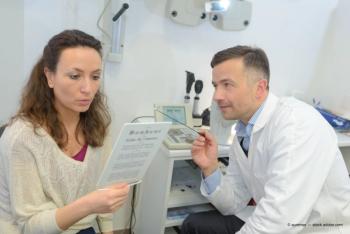
Taking note of a patient’s behavior can provide a multitude of clues on the patient’s current condition. Perhaps the most apparent observational feature would be a patient’s gait.

Taking note of a patient’s behavior can provide a multitude of clues on the patient’s current condition. Perhaps the most apparent observational feature would be a patient’s gait.

In the past decade, several significant advancements have been made in the arena of glaucoma diagnosis. Spectral domain optical coherence tomography (SD-OCT), newer algorithms in trend analysis of visual field studies, and combined visually evoked potential (VEP) and pattern electroretinography (ERG) studies have been the hallmarks of such recent advancements.

When I was a resident at the SUNY College of Optometry, I was asked a to conduct a few patient question and answer sessions regarding glaucoma. The sessions consisted of me sitting with a small group of patients, family members, or whoever wanted to know more about glaucoma.

Myopia control and prevention has become a popular topic due to more data on myopia becoming available.

ODs must have the right tools in their toolboxes when treating glaucoma correctly, says Optometry Times board member Michael Chaglasian, OD, FAAO, at Vision Expo East in New York.

Stem cell technology may soon enter the mainstream as a treatment for ocular disease, says Leo Semes, OD, FAAO, at this year’s annual SECO 2017 conference.

Most of the medications, both new and old, we prescribe for glaucoma are quite safe-especially if we educate our patients to occlude their puncta.

In the past couple of years, there has been discussion regarding dental and oral health-specifically the oral biomicrome-as possibly having a relationship to glaucoma.

Let’s examine what this specific (and separate) scan pattern can offer diagnostically

Before the new year gets too far along, let’s take a brief look at the happenings in the pages of Optometry Times during 2016.

As your patients celebrate another birthday milestone, they are again back in your chair wondering why their reading glasses mysteriously disappear when they are out exploring life or why their arms are not as long as they used to be.

Recently, I received a progress note from a glaucoma surgeon concerning a patient whom he and I share. The patient is a 58-year-old African-American female with a longstanding history of primary open-angle glaucoma.

Ben Gaddie, OD, FAAO, Optometry Times Editorial Advisory Board member, noted several specific areas that were advancing to give ODs better data and better control over patient health outcomes, including: • Corneal mechanics • 24-hour IOP monitoring • New glaucoma drugs and drug delivery systems • Advancements in OCT imaging

Glaucoma isn’t being treated aggressively enough, and eyecare practitioners are being too cautious when it comes to treating and diagnosing the disease-often at the patient’s expense.

After speaking at last week’s Republican National Convention in Cleveland, New Mexico OD Lisa Shin says more optometrists should get involved on a national level to keep optometry’s agenda at the forefront.

Not long ago, a colleague asked me if I performed Goldmann tonometry on all of my glaucoma patients. Without hesitation I said, “No.” When asked why not, I simply answered that not all of my patients are physically able to have the test performed on them.

The latest news and research you need to know about this week.

With the advent of electronic health records, it is now easier than ever to keep up with what medications a patient is actually taking, and (especially in the arena of glaucoma) the several classes of medications, such as steroids, beta blockers, and antihistamines, that can influence how patients’ eyes behave. With this in mind, I had a patient come in the other day with an interesting question regarding her intraocular pressure (IOP).

It’s been a busy week for ophthalmology research and news after both the Association for Research in Vision and Ophthalmology (ARVO) annual meeting in Seattle and the American Society of Cataract and Refractive Surgery (ASCRS) annual meeting in New Orleans.

Treating and managing chronic glaucoma can be rewarding as an optometrist. The frequency of office visits to monitor this chronic disease provides ODs an opportunity to develop a close relationship with their patients while providing medical eye care.

Researchers have found a significant correlation between depression and visual field loss in patients with glaucoma, according to a study in Ophthalmology.

What if glaucoma is actually a “two-pressure” disease caused by a differential between intraocular pressure (IOP) and cerebrospinal fluid pressure (CSFp)?

Congenital anomalies, angle closure, and juvenile open-angle glaucoma aside, it can be generally agreed upon that glaucoma tends to be a disease of relatively older persons. This rings especially true in the arena of normal-tension glaucoma in which intraocular pressure (IOP) may play less of a causative role compared to vascular and hemodynamic dysfunction.

It’s an oft-repeated mantra among those of us who treat glaucoma: The goal of glaucoma therapy is to maintain adequate functional vision until the patient dies. Like a lot of mantras, we spout it almost glibly.

It has been estimated that by the year 2020, there will be an increase in the number of Americans living with glaucoma from 60 to 80 million. Given that women outnumber and outlive men, this will result in a vast number of patients who will require optometric care.